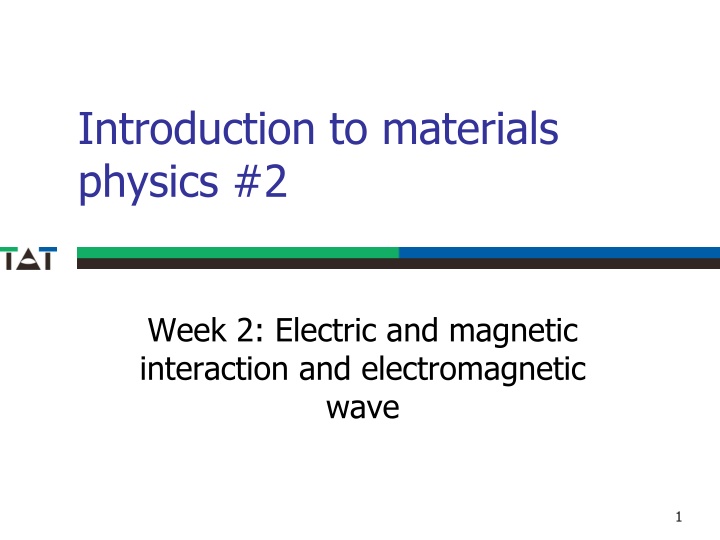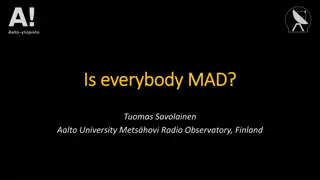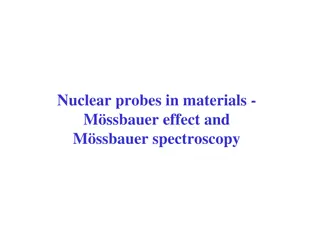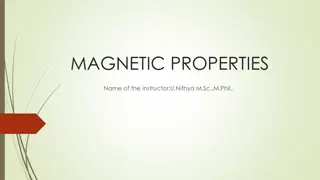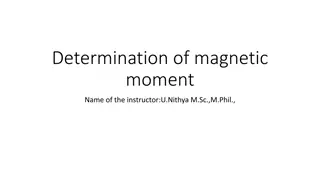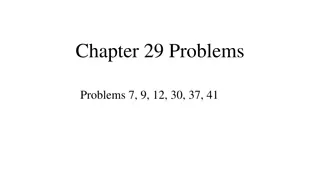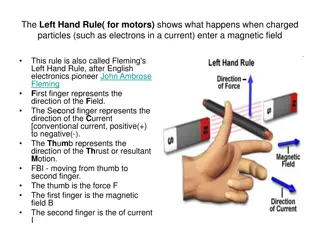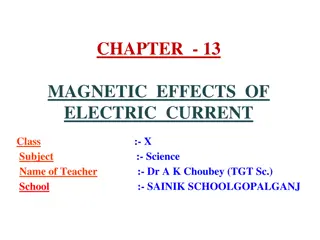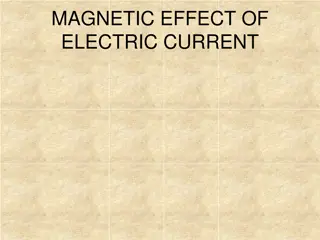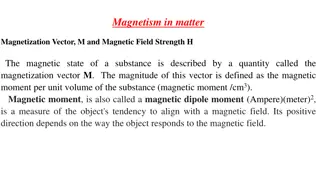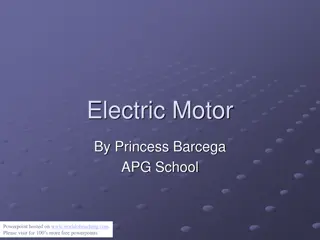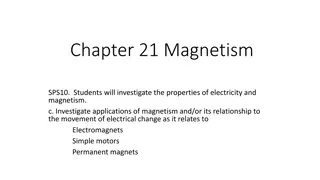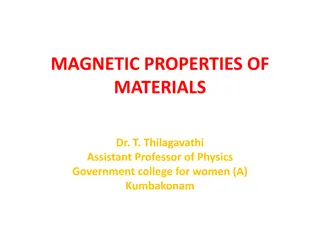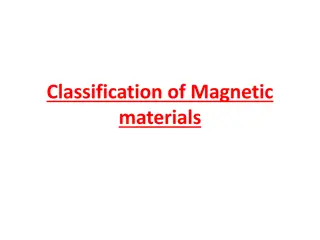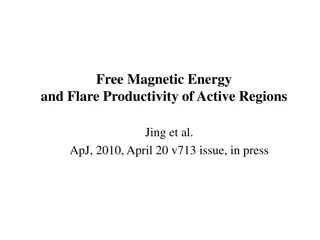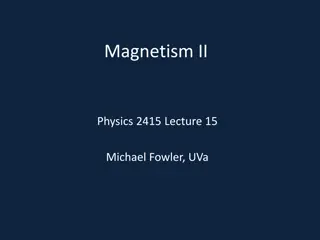Electric and Magnetic Interaction in Materials Physics
Concept of electric and magnetic interaction in materials physics, covering topics such as dielectricity, electric susceptibility, electric permittivity, and magnetism in a magnetic field. Understand the intrinsic constants and properties of materials in electric and magnetic fields.
Download Presentation

Please find below an Image/Link to download the presentation.
The content on the website is provided AS IS for your information and personal use only. It may not be sold, licensed, or shared on other websites without obtaining consent from the author.If you encounter any issues during the download, it is possible that the publisher has removed the file from their server.
You are allowed to download the files provided on this website for personal or commercial use, subject to the condition that they are used lawfully. All files are the property of their respective owners.
The content on the website is provided AS IS for your information and personal use only. It may not be sold, licensed, or shared on other websites without obtaining consent from the author.
E N D
Presentation Transcript
Introduction to materials physics #2 Week 2: Electric and magnetic interaction and electromagnetic wave 1
Electric and magnetic interaction and EM wave Static interaction of materials Electric field and dielectrics Magnetic field and magnets Dynamic interaction Faraday s law of induction Amp re s circuital law and displacement current Maxwell s equations and wave equation 2
Dielectricity: materials in an electric field Dielectric materials (dielectrics) possess electric polarization P in a static electric field E. Electric E = field Ve : [V/m] z d Q = P e Electric Polarizati = on : z S = 2 P E 0E [C/m ] electric : polarizabi lity vacuum : permittivi ty 0 electric : susceptibi lity 3 (non - dimensiona l)
Electric susceptibility An intrinsic constant of a dielectric material which describes its electric property. The values are different among the materials. By measuring the electric susceptibility, we can investigate the electric property of a material. 4
Electric permittivity of material Due to the electric polarization P, the density of the electric force line, D, is decreased. In order to keep the density of the electric force line, we must add P to that of vacuum ( 0E). : electric permittivity of material 0: electric permittivity of vacuum 5
Note: Why is P proportional to E? Induced electric polarization might be proportional to an applied electric field at weak-field limit, because 1. Without a field, the polarization should be 0. 2. A reversal field induces a reversal polarization with the same magnitude. A sufficiently strong field can violate the above linearity. If you pull a spring with an enormous force, the spring can not be extended any more. Odd function 6
Magnetism: materials in a magnetic field Magnetic materials become magnets in a static magnetic field. Magnetic H field : [A/m] md = M e Magnetizat M = ion : z dS H [A/m ] m magnetic : charge m magnetic : susceptibi lity m 7
Classifications of magnetic materials Paramagnetic materials They become weak magnets when they are subjected to an external magnetic field. Ferromagnetic materials They can be magnets without an external magnetic field. Diamagnetic materials They become weak magnets in the opposite direction with respect to the magnetic field when they are subjected to an external magnetic field. 8
Magnetic susceptibility An intrinsic constant of a magnetic material which describes its magnetic property. The values are different among the materials. By measuring the magnetic susceptibility, we can investigate the magnetic property of a material. 9
Dynamic interaction 1: Faraday s induction law A voltage is induced in a coil when magnetic flux crossing the coil is temporally changed. d = V d t [V] = Induced : BS = voltage V [Wb] : HS Magnetic H B = flux 2 [Wb/m : ] Magnetic flux density 10
Induced voltage V Induced voltage is evaluated from electric field Induced voltage (right-handed rotation) ( ) + ( ) = + 0 V E x E x 0 y + x y ( ) )( E ) ( )( 0 ) E y x E y y y ( ( ) = E y x y x + y ( ) ( ) 0 E y E y y Divided by S= x y ( E S Small area limit (S 0 x, y 0) ) ( ) 0 ( ) ( ) 0 x E E y E V y y = x x x y d E d d E d V y = x S x y 11
Differential equation of Faraday s law Faraday s law can be expressed by a differential equation of electric and magnetic fields. E E H d y = x z = V x y t dt EXERCISE: Derive the above right differential equation. 12
Dynamic interaction 2: Amp re s circuital law Infinite straight electric current induces magnetic field in the form of closed loop around the current. Induced magnetic field (right-handed rotation) I 2 = H r Magnetic : field H Electric : current I radius : of the loop r 13
Displacement current Current conservation The current flowing in a single loop circuit is the same everywhere. How is the current inside the capacitor? Q I d = = , d V = = , E d t S Q CV C d d E Displacement = I S I D current d t There exists displacement current inside the capacitor instead of current! Introducing displacement current density, I j D = d E D d S t 14
Magnetic field induced by displacement current Displacement current can induce magnetic field. Magnetic field induced by displacement current Electric field induced by temporal change in magnetic field 15
Differential equation of Amp re s law Amp re s law corresponds to Faraday s law. Amp re s law Faraday s law , E j = , H H E E x y x y d d induces magnetic field induces electric field D d d t t H E H E E H y y = = x x z z x y t x y t EXERCISE: Derive the above left differential equation. 16
Maxwells equations Maxwell s equations are the electric and magnetic laws given in the form of differential equation in arbitrary reference coordinate system. Coulomb s law electric : / div = E charge density No magnetic monopole 0 div = H Specific coordinates Faraday s induction law = rot E E E H t / y = H x z x y t Amp re s circuital law = rot H H + t / j E H E y = x z x y t Dj 17
Wave equation: field configuration Consider a specific case where magnetic and electric fields are at right angle to each other. Direction of electric field x-axis Direction of magnetic field y-axis Faraday s law H H E E E y y = = x x z z x t z t Amp re s law H H E E H y y = = x x z z t y z t 18
Wave equation: separation of electric and magnetic fields Electric field H z E y = x t H 2 2 E y = = x E E x x 2 2 z z z t z t Magnetic field H Wave equation E y = x z t H 2 2 E y = = x H H y y 2 2 z z z t z t 19
Wave equation in general coordinate system Specific coordinate system Faraday s law Wave equation H y x E 2 2 E y = = x z E E x x 2 2 t z t General coordinate system Faraday s law Wave equation t = / rot H E 2 = 2 E E 2 t 2 2 2 ( ) + + 2 Laplacian 2 2 2 x y z You will learn this in Electromagnetics I, II . 20
Wave equation and electromagnetic wave Wave equations of fields = 2 2 2 2 = H H E E x x y y 2 2 2 2 z t z t Solutions of wave equations (electromagnetic wave) ( ) ( ( ) ( 0 cos , = kz H z t H y ) , Amplitude : E H = + t , cos E t z E kz t 0 0 Angular : k ) 0 0 + x frequency Wave : number 0 Initial : phase 0 EXERCISE: Verify that the solutions satisfy the wave equations. 21
Electromagnetic wave https://www.nde-ed.org/EducationResources/CommunityCollege/RadiationSafety/theory/nature.htm 22
Summary Static interaction of materials Electric field and dielectrics Magnetic field and magnets Dynamic interaction Faraday s law of induction Amp re s circuital law and displacement current Maxwell s equations and wave equation 23
